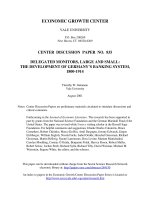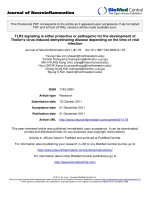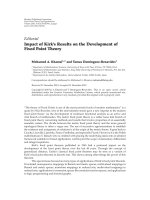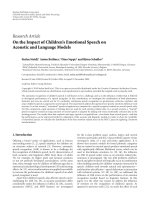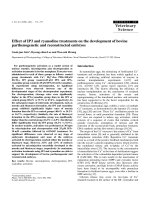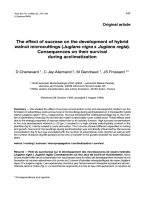141_Focusing on the Development of Children’s Mathematical Thinking: CGI
Bạn đang xem bản rút gọn của tài liệu. Xem và tải ngay bản đầy đủ của tài liệu tại đây (406.08 KB, 20 trang )
Focusing on the Development of
Children’s Mathematical
Thinking: CGI
Megan Loef Franke
UCLA
Algebra as focal point
“Algebra for All”
(Edwards, 1990; Silver, 1997)
“gatekeeper for
citizenship”
(Moses & Cobb, 2001)
Difficult transition from
arithmetic
Not move high school
curriculum to elementary
school
Engages teachers in a new
way, new content
Algebra as generalized arithmetic
and the study of relations
Viewing the equal sign as a
relation
57 + 36 = + 34
Using number relations to
simplify calculations
5 x 499 =
Making explicit general
relations based on fundamental
properties of arithmetic
768 + 39 = 39 +
Equality
8+4= +5
Equality Data (8+4=
+5)
Student Responses1
1
Grade
7
12
17
12 & 17
1st & 2nd
5%
58
13
8
3rd & 4th
9
49
25
10
5th & 6th
2
76
21
2
Falkner, K., Levi, L., & Carpenter, T. (1999). Children’s understanding of
equality: A foundation for algebra. Teaching Children Mathematics, 6, 232-6.
True/false number sentences:
from worksheets to index cards
Shift from a focus
on answer to a
focus on reasoning
Shift from a focus
on a single problem
to a sequence
Shift from sharing a
single strategy to a
conversation
around the
reasoning
Sequence of Number
Sentences
3+4=7
5 + 5 = 8*
7=3+4
6=6+0
6=6
6=3+3
4+2=3+3
* denotes false number sentence
Mathematical Content
Equality
Number Facts
Place Value
Number Sense
Mathematical Properties
Multiplication
Equivalence
7=7
5+5=4+6
250 + 150 = +100
45 = 100 + 20 +
5+6=6+
3× 7=7+7+7
½=¼+¼
Relational Thinking
24 + 17 – 17 = 34 +
1,000 – 395 = ___
999 – 395 + 1
Relational Thinking
Solve:
576 + 199 = □
1,000 – 637 = □
576 + 200 - 1
999 – 637 + 1
4 x 24 + 5 x 24 = □
10 x 24 - 24
Generating Conjectures
Making relational thinking explicit
Representing
Conjectures
b+0 = b
c+d = d+c
Variables
k + k + 13 = k + 20
Experimental Study Design
Volunteer, urban, low
performing elementary schools
in one district (19)
District working to improve
opportunities in mathematics
Schools randomly assigned to
year 1 or year 2 professional
development work
School site based PD monthly
On site support
End of one year assessed
teachers (180) and students
(3735)
Teacher Findings
Generating strategies for 8 + 4 = + 5
No differences in
teachers’ perceptions on
time spent on algebraic
thinking tasks in
classrooms
No differences on
knowledge of algebra
Differences in teachers’
knowledge of student
thinking- strategies and
relational thinking
Numb
er of
strate
gies
Participat Noning
Participati
Teachers ng
Teachers
1
6%
44%
2
38%
41%
3
25%
12%
4 or
more
31%
4%
Student Findings
Students in algebraic
thinking classrooms
scored significantly
better on the
equality written
assessment.
Students in 3rd and
5th grades were twice
as likely to use
relational thinking
Publications
Book for teachers:
Carpenter, T., Franke, M., & Levi, L. (2003).
Thinking mathematically Integrating
arithmetic and algebra in elementary school.
Portsmouth, NH: Heinemann.
Research article:
Jacobs, V., Franke, M., Carpenter, T., Levi, L. &
Battey, D. (in press). Exploring the impact of
large scale professional development focused
on children’s algebraic reasoning. Journal for
Research in Mathematics Education.
Conjectures
Is a focus on children’s thinking
enough?
Show what students are capable of
Counter narratives
Change what we consider basic skills
Create ways in schools to make room for
understanding
Watch for how the status quo limits
opportunities…find ways to challenge it



